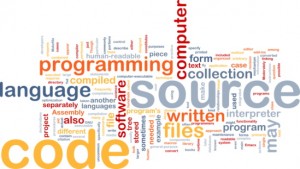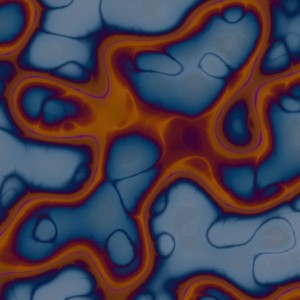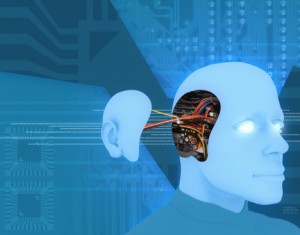All Things Digital: Part 2
By Asher Crispe: March 18, 2011: Category Inspirations, Quilt of Translations
 Now that we have established the connection of creation to a Jewish conception of information theory in Part One, we can now look to real-world applications. We live in a participatory universe. If God uses digital information to create, then we also need to partner in that creation of digital information by being programmers. Reprogramming the universe is not only permitted, it is mandated in order to complete creation and establish a hospitable environment for the expansion and rectification of life.
Now that we have established the connection of creation to a Jewish conception of information theory in Part One, we can now look to real-world applications. We live in a participatory universe. If God uses digital information to create, then we also need to partner in that creation of digital information by being programmers. Reprogramming the universe is not only permitted, it is mandated in order to complete creation and establish a hospitable environment for the expansion and rectification of life.
From a Jewish perspective, we are intended to be a kind of Divine mirror. ‘To walk in His ways’ implies that our existence can attempt to approximate expressions of Divinity. Noting that the primary name for the Divine in Hebrew is the ineffable name of four letters which rearrange to spell the word Havayah meaning ‘Being’ we might be tempted to borrow from 20th century philosophy and express the imperative to emulate the Divine in less theological terms.
If the essential manifestation of Divinity is Being itself (thus making the expression “God is” a redundancy as if to say ‘Is is’) then it follows the perspective of the mystics that we as humans are the beings who are endowed with the capacity to embody Being on the whole. Not only that but, in the terminology of the philosopher Martin Heidegger, we are the being who is concerned with Being as a whole. As a particular being or entity (what Heidegger calls the ontic) we are bound up with questions of the ontological (the whole of Being—perhaps the whole of reality or existence). Thus, one of the essential relationships that characterizes our lives may be termed the yearning for symmetry between the ontic and the ontological. In a less obscure rewording of this idea, we might simply contend that humans want their individual lives to mean something of universal significance. This would be like a person saying that ‘my life is the key to understanding Life in general’.
From the get-go, God appears in the Torah as a Creator. Since the first Divine activity we read about is that of world creation and with it the creation of life (not to mention the singled-out creation of human life), it follows that we should strive to emulate all of these same things. In this age of new media and technology, we might come to understand ‘emulate’ as ‘simulate’. Can we simulate the process of creating the universe? Well, we’re trying. This is precisely the reason that billions of dollars were spent on the Large Hadron Collider in Geneva Switzerland.
As the world’s largest and most expensive science experiment ever, it better be going after something big. In fact, this massive particle accelerator is doing just that. Scientists want to recreate the Big Bang with which they think the universe came into existence. Only, clearly, they want to do it on a smaller scale—try a small bang with similar conditions but without the side effects of destroying us and everything in the process. Using finely tuned mathematical modeling, the hope is to canvass the creative process that produced the universe in a digital mountain of information that will take years to decode but should hopefully shed some light on how all this stuff works. While we will likely be waiting for some time for a book on ‘How to make your own cosmos’ to be published, the important thing is that we are striving to make better and better simulations.
What about simulating life? Synthetic Genomics is the name of a company founded by biologist Craig Venter who had already achieved world fame and a place in the annals of science by being one of the first to successfully sequence the human genome in 2001. Not content with that benchmark achievement, Venter went on to lead a team of researchers to create what has been dubbed the first ‘synthetic life’ in May of 2010. This new, single-celled organism whose DNA code was written by a computer, has demonstrated the ability to reproduce and even possess coded ‘watermarks’ with which the scientists can keep tabs on it and its descendants.
 And what of emulating or simulating human life? In this area, there is progress being made on a number of fronts. Now that the body and brain are being treated as information systems that have entered the digital age, the pace of progress is simply mind-blowing. In addition to the genomics or bioinformatics of Venter and thousands of others, breakthrough modeling is occurring in the areas of neuroscience, artificial intelligence, and robotics research. According to some standards of measurement, we are more than doubling our knowledge every year! Computers themselves are displaying greater and greater aptitude for mimicking key features of human intelligence. While no one yet knows at which threshold of complexity something like artificial general intelligence will come online, the small victories are adding up to very significant new technologies that are already, in limited cases, outstripping natural human capabilities or at least simulating them quite realistically.
And what of emulating or simulating human life? In this area, there is progress being made on a number of fronts. Now that the body and brain are being treated as information systems that have entered the digital age, the pace of progress is simply mind-blowing. In addition to the genomics or bioinformatics of Venter and thousands of others, breakthrough modeling is occurring in the areas of neuroscience, artificial intelligence, and robotics research. According to some standards of measurement, we are more than doubling our knowledge every year! Computers themselves are displaying greater and greater aptitude for mimicking key features of human intelligence. While no one yet knows at which threshold of complexity something like artificial general intelligence will come online, the small victories are adding up to very significant new technologies that are already, in limited cases, outstripping natural human capabilities or at least simulating them quite realistically.
Here comes the punch line of it all. Of the scores of rabbis immersed in the secrets of Sefer Yetzirah, one of the most famous was Rabbi Yehudah Loew (1520-1609). Known as the Maharal of Prague, Rabbi Loew is perhaps best known for his legendary creation of a Golem. The Golem is described as a humanoid creature that was artificially brought to life using the information technology contained within the traditions of Sefer Yetzirah. For many historians, the Golem represented the source inspiration for our modern concept of robots as well as synthetic life and artificial intelligence. In various accounts, the process of Golem-making sounds akin to the programming of an information system. The combining of this information system with physical substance made for a kind of reprogrammable matter that simulated life on some level.
While the issues surrounding the kabbalistic traditions of Golem-making are too vast to address at this point, let us suffice to point out some of the foremost venerated scientists who claim to trace their family lineage back to the Maharal.
As documented in several academic works (notably Machines Who Think by Pamela McCorduck and The Second Self by Sherry Turkle) these scientists include:
Norbert Wiener (1894-1964) the founder of cybernetics and a major contributor to the nascent stages of AI research, computer science, and neuroscience
John Von Neuman (1903-1957) whose computer science contributions include a design architecture used in virtually every computer in the world today, not to mention his contributions to quantum mechanics, game theory, and a host of other disciplines
Marvin Minsky (1927- ) a founding father at MIT of modern robotics and artificial intelligence research
as well as a number of other computer scientists and physicists.
 More than being the descendants of the famed Rabbi, each of these pivotal figures has exhibited a profound intellectual heritage and kinship with the teachings of the Maharal, many of which may be viewed as an unpacking of the essential insight of Sefer Yetzirah—that everything is created out of information. Throughout his vast body of writing, the Maharal, again and again, returns to the theme of abstract form or information and its relationship to substance as the underlying drive of many of the concepts in the Torah and Talmud. One even gets the sense that for the Maharal, one of the most important insights of Judaism is the centrality of information theory and the notion of creation as information processing.
More than being the descendants of the famed Rabbi, each of these pivotal figures has exhibited a profound intellectual heritage and kinship with the teachings of the Maharal, many of which may be viewed as an unpacking of the essential insight of Sefer Yetzirah—that everything is created out of information. Throughout his vast body of writing, the Maharal, again and again, returns to the theme of abstract form or information and its relationship to substance as the underlying drive of many of the concepts in the Torah and Talmud. One even gets the sense that for the Maharal, one of the most important insights of Judaism is the centrality of information theory and the notion of creation as information processing.
Spiritually speaking as well as scientifically, programmers are needed. Realizing the promise of the digital age is to embrace boundless creative freedom and the hope of a better world.
All Things Digital: Part 2,













;)
;)
;)
;)
;)
;)
;)
;)
;)
;)

This series are nothing short of excellent!